Experience Oz Blog The Best Places in Australia to Visit in August
By Experience Oz TeamAugust in Australia marks something of a transitional period, with the heart of winter gradually edging towards spring, and as a result, the weather at the start of the month and the end can be quite drastic contrasts to one another.
If you’re looking for a destination for travel during this part of the year, the main deciding factor may come down to exactly what kind of holiday you’re looking for as some destinations are more oriented towards indoor and city-based experiences where others emphasise enjoying nature and the Great Outdoors.
August also traditionally provides lower levels of rainfall than most other months across the board, and while lower temperatures are a given, the benefit of lower humidity can often make some other typically-stifling spots in Australia’s hot climate far more bearable.
Taking these factors into account, where then are the best places in Australia to travel during August? Here’s our list of 6 top spots to visit in August.
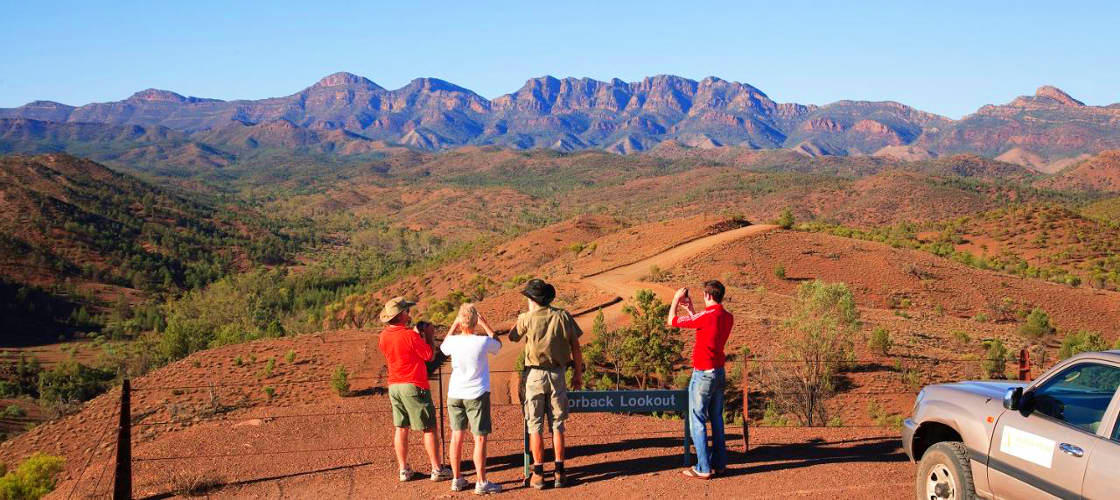
6. Flinders Ranges & Outback, SA
Average temperatures: 7.6 degrees Celsius – 21.0 degrees Celsius
Ideal for: Adventurous travellers looking to get outside
Top Things to do: Wilpena Pound hike or scenic flight; 4WD self-drive or tours; Umoona Opal Mine; Coober Pedy opals; ride the Pichi Richi Railway; walk the Heysen Trail; stay at Arkaroola Wilderness Sanctuary
While most might plan a trip to South Australia to orient themselves around the likes of world-class wineries, Euro-centric architecture and dashes of wonderful coastline, there’s an element to the state that turns this popular conception on its head while being strikingly beautiful in its own right; the South Australian Outback.
A word typically associated more intrinsically with the Northern Territory, SA’s Outback has plenty to offer the adventurous traveller, with the cooler months, such as August, helping to alleviate the otherwise fiery heat of the state’s interior.
This is an ancient and sunburnt landscape that’s home to a number of natural marvels and experiences while also remaining relatively under-visited. As a result, it’s an excellent choice of locations for those looking to truly escape from the crowds and unplug. It all starts by hitting the road and venturing north of Adelaide – a 4WD-capable vehicle is not mandatory but helps remove plenty of potential barriers to further adventure – for around 200km before the initial peaks of the expansive Flinders Ranges come into view.
The Flinders serve as something of a natural (and enormous) signpost to entering Outback SA, and offer a nearly endless array of offroad trails and tracks on which to go exploring, highlighted by the popular Skytrek route that winds its way through a mixture of striking mountain valleys, tree-lined creeks and plenty of historic points of interest from past habitation.
Habitation is something that’s truly lacking in the current Flinders Ranges – the largest town is Hawker, with a population that hovers around the low hundreds – and as such those looking for elaborate creature comforts and conveniences may find the region wanting. For most, however, this is a built-in part of its charm and a necessary compromise for encountering some of South Australia’s most unique sights.

Chief among these is the massive natural amphitheatre of Wilpena Pound, which juts prominently out of the landscape around 55km from Hawker.
With a number of peaks encrusting its roughly circular shape and an interesting interior that can be explored both via a number of walking trails or on a stunning scenic flight that ranks alongside Australia’s best, it serves as the main highlight of the region for many first-time visitors.
The rest of the Flinders Ranges is no slouch, either, as there are numerous other features ranging from Aboriginal sites, massive gorges and even dashes of vivid colour and flora, particularly after recent rainfall.
Of course, Outback South Australia does not stop at the Flinders Ranges, press on further north and you’ll encounter the Arkaroola Wilderness Sanctuary, the vast, salty expanse of enormous Lake Eyre, and to the north-west, the iconic outback town of Coober Pedy with its renowned mixture of opals and underground living.
Living underground is a way of life in this mining town, with scorching hot days often making subterranean dwellings a far cooler and more comfortable alternative. It’s only fitting, then, that one of the town’s key attractions is a full-blown showcase of the underground world, with Umoona Opal Mine and Museum being converted into a comprehensive tribute to the region’s history, industry, indigenous culture and innovative construction techniques.

As Coober Pedy was a town built on the back of opals, the gemstones feature prominently in the attraction, the experience starts with a short video detailing how they are formed, then carries on to showcase an example of a typical underground home, known as a dugout.
Visitors have the ability to wander through the mine’s curated sections and absorb the detailed information at their own pace, while there’s also some wonderfully-produced material chronicling the Aboriginal perspective on the region and its opals. And, of course, any visit to Umoona must conclude with some gawking over some of the spectacular opal-oriented jewellery on display that is available at competitive prices and amazing in their colouration.
Add in the potential for several other incredible journeys on both foot and rail, and a trip here expands even further. The Heysen Trail, a portion of one of Australia’s greatest walks, encompasses parts of the region, and while walking the entire track takes roughly 60 days, even a single day on the track can provide a perspective on raw Australian nature that relatively few get to experience.
The Outback of SA is also home to two magnificent train trips; the Pichi Richi Railway that meanders its way at a leisurely pace through the Pichi Richi Pass in the Flinders Ranges between March and November, and the more epic and symbolically-Australian Ghan rail journey that connects Adelaide with Darwin over a period of four days.
In all, the region is large enough in both scale and scope to form the backbone of a number of incredible itineraries; leave those creature comforts at home and you’ll end up with one of the purest ways to embrace raw Australia with a journey to SA’s Outback.
Explore Flinders Rangers Experiences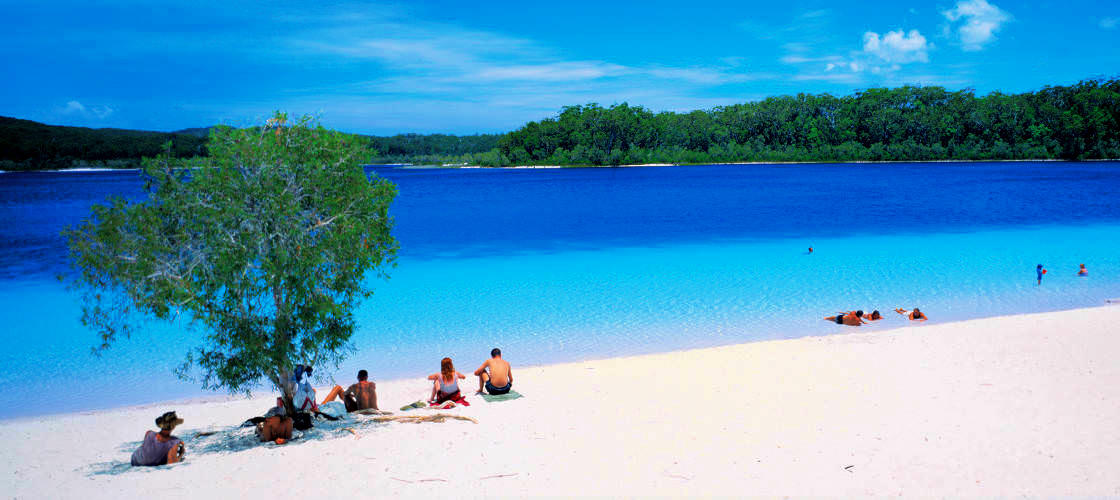
5. Fraser Island, Queensland
Average temperatures: 14.1 degrees Celsius to 25.0 degrees Celsius
Ideal for: Relaxing island getaways and those who don’t mind swimming in cooler waters
Top Things to do: Visit Lake Mackenzie; the Champagne Pools; Eli Creek; 75 Mile Beach; Maheno Shipwreck; Central Station Rainforest
The world’s largest sand island lies off the coast of Queensland’s Hervey Bay, and is renowned for its blend of natural displays ranging from multicoloured sands to rare species of wildlife and ancient rainforests.
Given its ease of accessibility and sheer diversity, Fraser Island remains a remarkably underrated Aussie travel destination and is more often a favourite of Queenslanders and other locals who are knowledgeable about its many offerings.
While this part of Queensland is typically warm and sunny throughout most of the year, the combination of lower air temperatures and cool sea breezes during August remove any trace of the sometimes-uncomfortable humidity that Fraser can experience during the hottest periods of the year.
While mornings and nights can still be cool in times when the wind picks up, you’ll still be able to experience the majority of the joys of Fraser Island’s nature without having to fight crowds during August and still be treated to wonderful weather for relaxing on its many beautiful beaches.
Temperature averages for August during the day are a comfortable maximum of 23 degrees Celsius and edge up towards 24 – 25 degrees Celsius as the end of the month approaches.
While this may prove to make the beaches of Fraser Island un-swimmable for many – both because of their shark-laden nature and the chilly water temperature – the island is home to numerous shallow lagoons, lakes and creeks that provide an excellent alternative option for refreshment on warmer days.
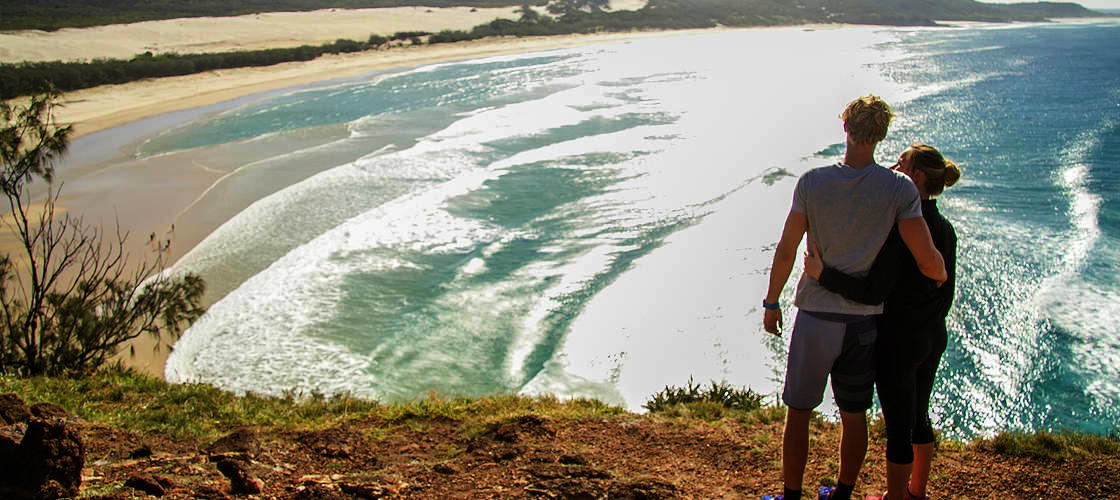
August also brings with it other natural benefits; it’s an exceptionally popular destination for fishermen, as the numbers of tailor available for catch draw fishing enthusiasts from far and wide. The month is also peak season for Fraser Island’s wildflowers, which add an additional layer of colour to what is already an impressive natural landscape.
This floral display mixes with the climate conditions to make August one of the best times of the year to take part in one of Fraser Island’s many potential extensive bush walks. From shorter strolls along the beach all the way up to the full epic scope of the Fraser Island Great Walk track; a wonderful journey that can be conducted over the span of 6 – 8 days depending on how many diversions you’re looking to take.
During the walk, you’ll get a comprehensive overview of the island’s mixture of mangrove forest, crystal-clear freshwater lakes, and other topography that make it such a special place.
Not everyone will have so much free time to spare on their holiday, however, and it’s a good thing that a decent cross-section of Fraser Island’s offerings can be experienced in a shorter span if necessary.
While day tours are available, travellers should stay at least one night on the island as the sheer size of it means you’ll only be able to cover this single area.
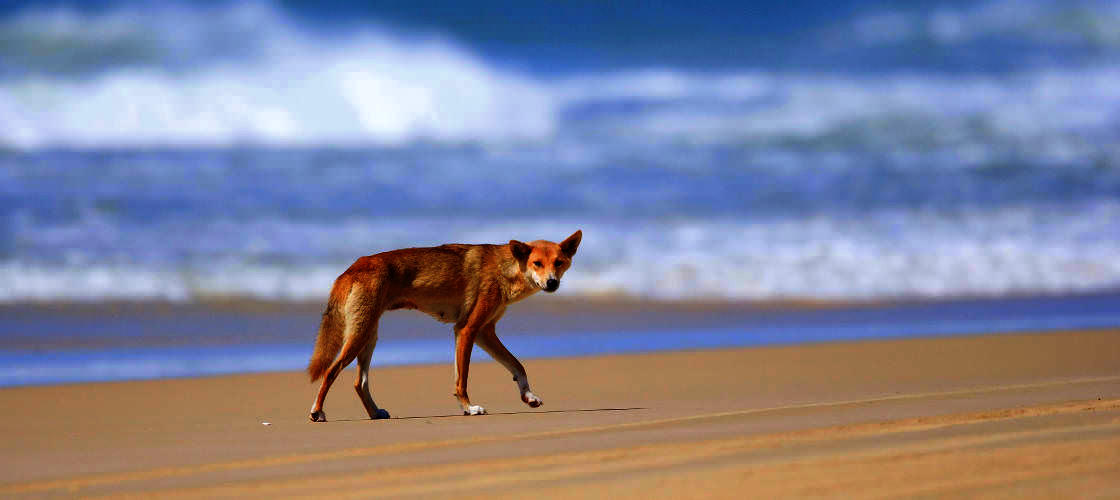
However, day trippers can still see a significant amount such as Lake McKenzie, Eli Creek, the Maheno Shipwreck and others. As a result, other must-see locales on Fraser Island that lie further away such as the wonderful Champagne Pools, Indian Head and more, will be missed on a single-day itinerary which is why the 2-day minimum comes highly recommended.
Getting to Fraser Island is typically done via a ferry that can take both pedestrians and vehicles (4WD only) over the water from Hervey Bay, while those with money to spare can book an air charter for a landing on either a grass airstrip or on the expansive 75 Mile Beach itself. Chartered tours for 1 to 3 days are also offered via tour operators (see our Hervey Bay tours section for options) that aim to cover the majority of the island’s essentials on their itineraries.
If you’re looking for an alternative destination in Australia during August that will help you escape the cold yet not as commercialised as some other tropical QLD offerings, give strong consideration to Fraser Island; you’ll be glad you did.
Explore Fraser Island Experiences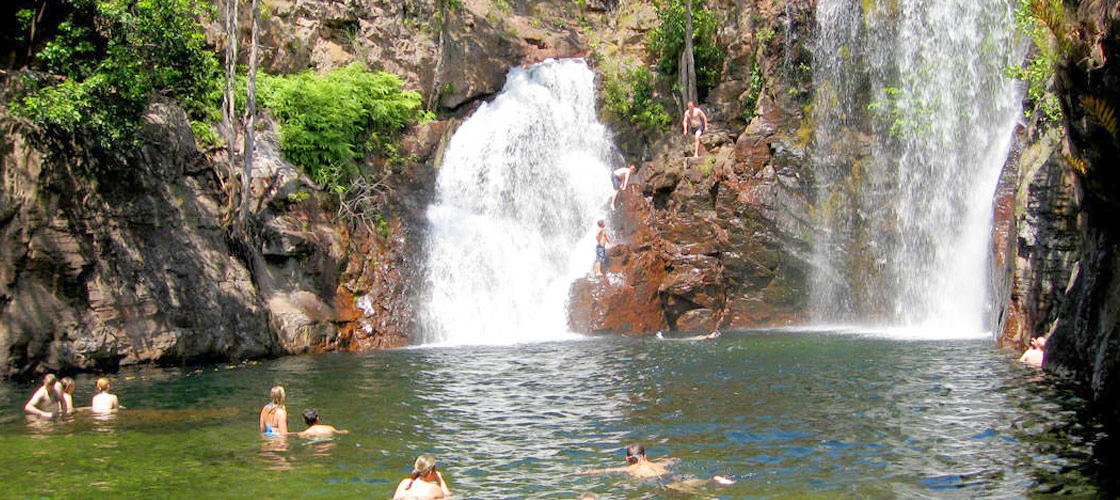
4. Litchfield National Park, NT
Average temperatures: 17.8 degrees Celsius to 33.0 degrees Celsius
Ideal for: Holidaymakers seeking an outdoor escape with beautiful natural attractions
Top Things to do: Visit Blyth Homestead; the Lost City; Florence, Wangi & Tjaynera (Sandy Creek) Falls; see the magnetic termite mounds; swim in Bluey Rockhole
The less famous little brother of Kakadu National Park, Litchfield National Park in the Northern Territory is equally spectacular in its own way, and its compact size and easier accessibility from Darwin make it a much more reasonable proposition to explore.
Home to an incredible array of ruggedly beautiful environments, Litchfield offers much of the marvel of Kakadu just over an hour’s drive away from the Northern Territory’s capital.
From beautifully clear swimming holes to sheer cliff faces, rushing waterfalls, towering termite mounds and various other examples of raw and untouched Australia, it is a beautiful sight. As a result, getting a sampling of Litchfield’s marvels is doable in a single day as opposed to Kakadu.
August in Litchfield and its surrounds falls within its dry season – this part of the Northern Territory only has two major seasons, the wet and the dry as far as the average traveller is concerned – and as a result of much more of the area, as well as some additional camping areas, is open and accessible.
The difference between the NT’s national parks in the wet and dry seasons is dramatic enough to make them seem almost like two entirely different locations, and they are worth visiting during each if you’re ever planning a return visit.
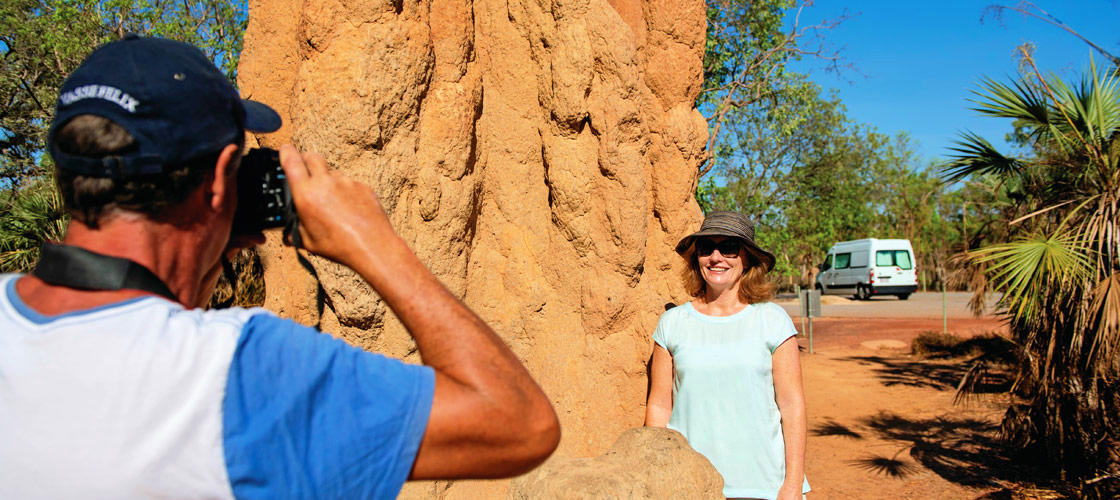
Traditionally an area that gets extremely hot and humid during the wetter summer months, winter becomes the peak tourist season for Litchfield as many are drawn from colder, southern states to explore this part of Australia’s heartland under much warmer conditions.
The inevitable downside that comes with this favourable weather is that Litchfield National Park’s waterfalls aren’t as powerful or dramatic as they are in the wet season, however, this is the tradeoff made for the benefits of more comfortable and predictable weather.
This is particularly crucial for a destination such as Litchfield which is entirely based outdoors and will have you walking through some densely forested areas. August as a travel time means you’ll have to dedicate far less energy to deal with one of the pesky natives; the dreaded mosquito.
In addition, picking August avoids the majority of Australian school holiday periods which helps reduce fellow tourist numbers and leads to retaining some of the isolation and seclusion of this natural area without having to fight for viewing spots or share swimming holes.
In terms of how to spend your time at Litchfield, you’ll both be spoiled for choice and be able to access them all in relatively short order as the majority of the park’s main highlights are located within close proximity to one another. In all, it’s a very easy National Park to find your way around compared to the vastness of Kakadu.
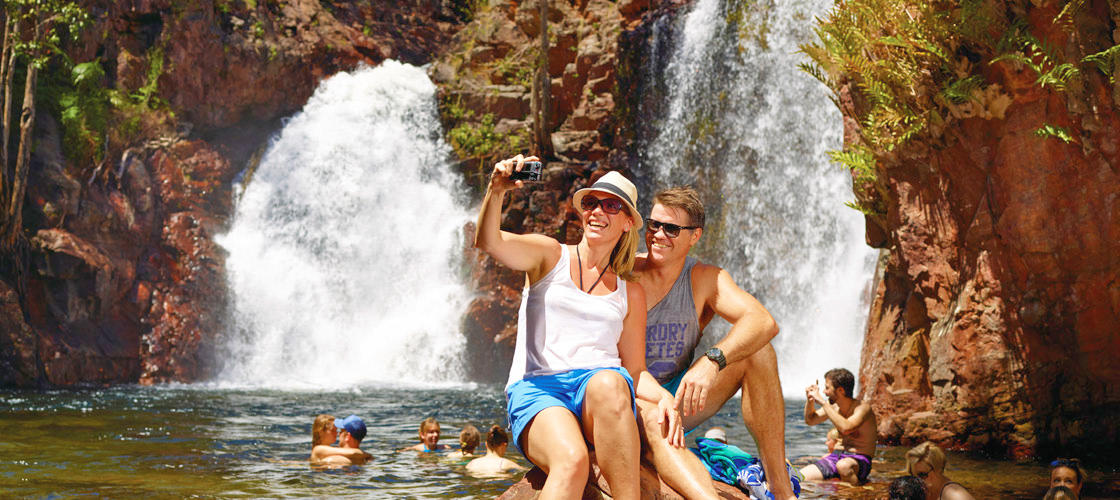
Which key parts of the park appeal to you will depend on personal taste and what you’re looking for; swimming in natural waterholes, in particular, is a major drawcard of Litchfield, there’s some quality spots to swim at Buley Rockhole, and both Florence and Wangi Falls. All of these can be visited in one day and so you may simply determine which is the least crowded and spend the most time there.
The iconic magnetic termite mounds – hundreds of often-towering insect-built structures that face north-to-south – are viewable from the main road inwards and you’ll undoubtedly see them on the way in, and there are numerous opportunities for short walks and hikes available.
Many of these walks are relatively easy and maintained, and Litchfield National Park has a good range of picnic facilities throughout when sticking to the main tourist tracks which make enjoying your own lunch in lovely surroundings a breeze.
There are few day trips from Darwin that can compare to Litchfield National Park, and August brings along with it pleasurable conditions to what is one of the Northern Territory’s must do’s.
Explore Litchfield National Park Experiences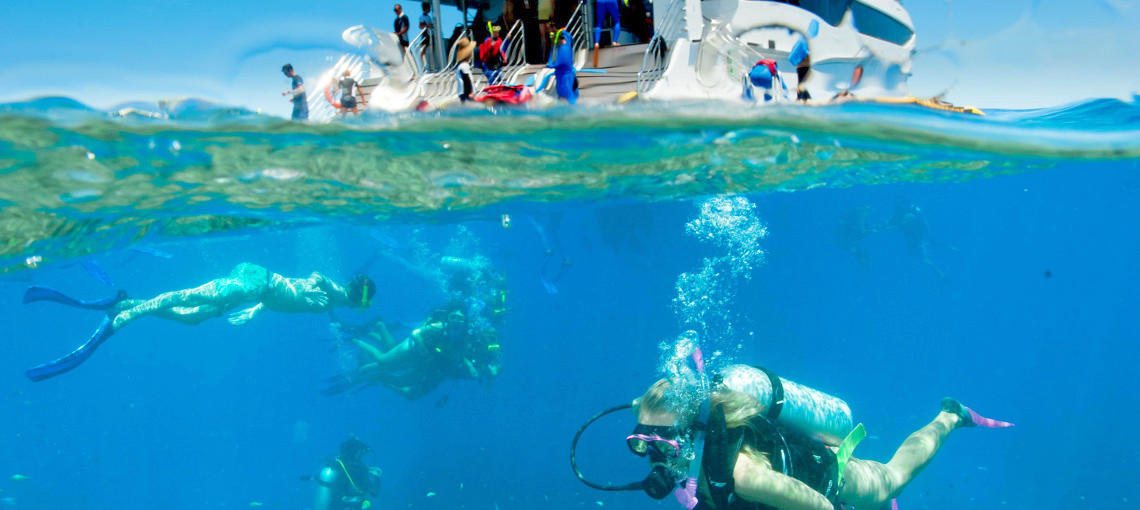
3. Cairns, QLD
Average temperatures: 17.4 degrees Celsius to 26.6 degrees Celsius
Ideal for: Travellers looking to escape the cold and explore the reef and rainforest
Top Things to do: Snorkel or dive the Outer Reef; visit Green & Fitzroy Islands; the Cairns Botanic Gardens; ride the SkyRail Rainforest Cableway; go whitewater rafting; bungee jumping; or go hot air ballooning.
Much like Litchfield above, Cairns is another popular travel destination where humidity plays a large role in the associated level of appeal for visitors making their way for a trip.
Perhaps Australia’s most famed destination for those looking to explore all the wonders of the Great Barrier Reef, Cairns’ location in Queensland’s tropical north brings along with it all the associated weather and climate conditions.
Aspects such as the aforementioned humidity, regular thunderstorms with heavy and copious amounts of midges and mosquitoes all come into play to varying degrees throughout the year. It’s particularly important in a destination where most will want to spend a great deal of their time either in, on, or under the water that the sunshine and a lack of rain are the names of the game and it’s here that August shines in Cairns exceptionally well.
The peak of winter is a term that might apply to many destinations in August, but in Cairns, it’s easy to shrug off with an ideal daily average maximum temperature of 26.5°C (79.7°F) and the lowest amount of rainy days of any other month of the year in the region.
This far greater chance of sunny days makes planning an enjoyable reef trip much more predictable and viable in other months of the year and is a crucial element to not having your Cairns visit spoiled.

Given Cairns’ popularity as a travel spot, costs can also be cut by travelling in August as opposed to the busier July. As a result of the lack of school holidays prices may still be fairly high given Cairns’ global appeal, but it’s one less factor to contend with when booking accommodation or tours. This also avoids the bulk of the overseas/international peak reef season as well.
While travelling to Cairns in what is relatively a cooler time of the year can have the drawback of lower water temperatures, when hitting the Great Barrier Reef for a day trip most tour companies will provide wetsuits as part of their packages upon request.
There are also numerous facilities in and around Cairns where wetsuit hire is offered. If you’re the type that’s sensitive to cold conditions they’re well worth investing in. August in Cairns also tends to be fairly windy which may add an additional chill when getting out of the water.
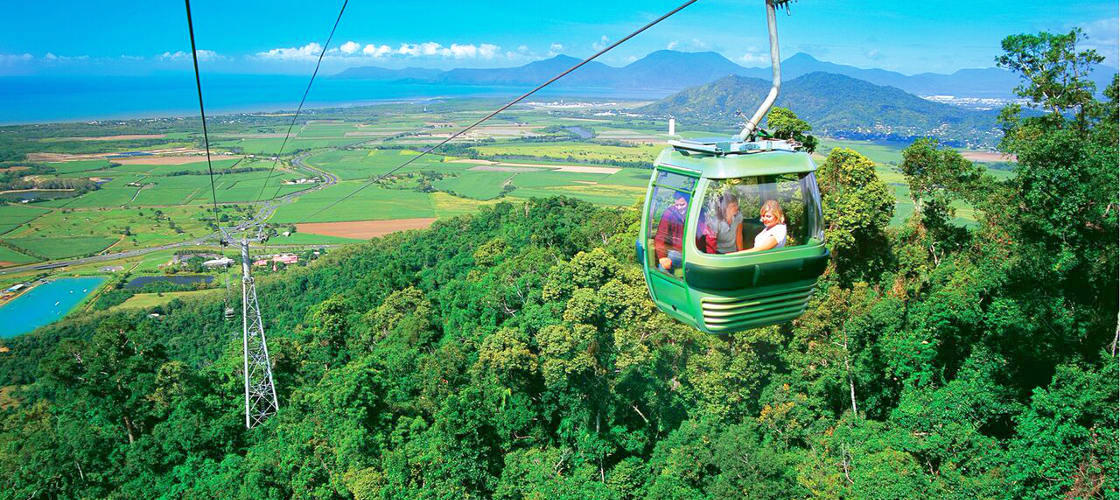
Of course, you don’t have to spend the entirety of your time in Cairns, trips out to the likes of Green Island and Fitzroy Island attempt to provide just as much entertainment on land as in the water. The simple act of lazing on the beach draped in the sunshine makes for a welcomed escape from the cold of most southern Aussie states.
Likewise, the World Heritage protected rainforests that surround Cairns offer an entirely different world to the Reef to explore with numerous possibilities for travellers to explore in a variety of ways. The rainforest’s humidity is also reduced during this period and plenty of activities from the SkyRail Rainforest Cableway to river cruises and simple guided walks benefit from these favourable conditions.
Most first-time visitors to Australia will want to include Cairns on their itinerary at some point, and if you’re wanting to experience the region at what is perhaps its best balance of weather, crowding and price then August checks all the appropriate boxes.
Explore Cairns Experiences
2. Port Stephens, NSW
Average temperatures: 9.8 degrees Celsius to 18.9 degrees Celsius
Ideal for: Wildlife and scenic lovers
Top Things to do: View from Gan Gan Lookout; go sandboarding; take a dolphin cruise; snorkel at Fly Point; learn to surf; go Quad Biking; Toboggan Hill Park
The central coast of New South Wales is another strongly underrated travel destination that brings with it many of the benefits of the more famous south-east Queensland destinations without nearly as much crowding and typically cheaper overall prices.
Port Stephens is perhaps its most picturesque spot, this large, natural harbour in the Hunter region offers plenty of fun to be had both in and out of the water for days in August when you feel it’s too cold to swim.
Located just over 2-hours to the north of Sydney (or far shorter from Newcastle), it’s an easy drive that brings along with it numerous natural rewards for the aspiring visitor.
The reason for Port Stephens’ aquatic offerings being so popular are several; not only are they clean, spacious and picturesque to explore, but they’re also teeming with marine life that comes to the forefront during August and some of its surrounding months.
Whale watching is a big drawcard for the Port Stephens region, and the beginning of August lies right in the heart of the migratory period of these huge yet gentle giants of the ocean.

As a result, whale watching is one of Port Stephens’ most popular activities for tourists and can be done from both on land (within the bushy Tomaree National Park) and on a range of whale watching cruises conducted by local operators. Whales aren’t the only mammals to populate the waters around Port Stephens, either, as it also serves as the base for over 100 bottlenose dolphins.
Other water-based experiences also play a large role in the activity scene here. Surfing is popular with lessons provided by a range of local surf schools, fishing is great with both on and offshore possibilities for catching a game, and even snorkelling is more than viable at the popular Fly Point that sits within the Halifax Park Aquatic Reserve that even novice snorkelers can enjoy.
There’s a wide array of fish and marine life to be witnessed here, as well as a solid concentration of crustaceans and sponges that add an additional layer of variety to the seascape. Port Stephens’ other major standout natural feature is its expansive sand dunes, and if there’s any one activity that’s emblematic of Port Stephens as a whole, then sand boarding is probably it.
A staple activity of youths growing up in the region, it’s a simple pleasure that can be enjoyed by all ages, and the moderate August weather means the impact of the sun on the dunes and its reflection is minimised somewhat if you’re planning to spend several hours here.

These dunes are impressive in size – they’re the largest of their kind in the Southern Hemisphere – and can be reached via 4WD tours that also provide the optional chance to take in some of the history and geographies of the surrounding area.
Lastly, August’s famously clear skies make one of Port Stephens’ absolute must-do experiences, the trip up to Gan Gan Lookout, even more pleasurable. The region’s most impressive panorama, clear days result in a great degree of visibility from which you’ll be able to take in the beautiful blue waters of the bay and its various dotting islands, the surrounding greenery, and some of the town itself.
Couple all of the above with the ability to find uncrowded stretches of lovely beach that you can have practically to yourself, and Port Stephens idyllic balance of natural offerings and a lack of over-commercialisation make it an easy destination to recommend for those who want a seaside getaway.
Explore Port Stephens Experiences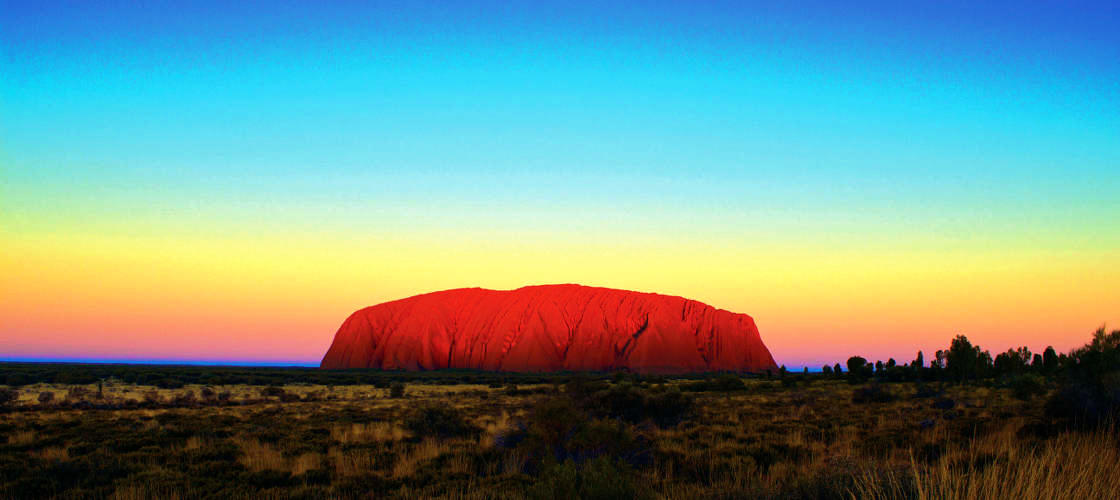
1. Uluru, NT
Average temperatures: 5.5 degrees Celsius to 22.6 degrees Celsius
Ideal for: The ultimate Aussie outback escape
Top Things to do: see the sunset/sunrise at Uluru; take a camel ride; do the Sound of Silence experience; take an Uluru helicopter flight.
Perhaps more than any other destination outside of maybe the Great Barrier Reef, this is the destination we most often get asked as to when is the best time to visit. As one of our country’s truly amazing and internationally-recognised icons, Uluru/Ayers Rock is a site where the term ‘bucket list item’ isn’t just a cliché, it’s actually 100% true.
Situated almost exactly in the centre of the Australian continent, the massive stone structure combines amazing scale with isolation and cultural significance into a single unique package that can’t be found anywhere else in the world.
As Uluru’s isolation is one of its most appealing features, it also makes travel to the rock quite an effort, and it’s important to ensure you travel at the best possible time, which we feel is the tail end of August for a number of reasons.
Found in a location that is basically a desert, weather and climate come into play in the Uluru region just as much, if not more so, than any other destination on this list. As a result, both summer and the raw middle of winter (July in particular) are recommended to be avoided, for differing reasons.
While most people’s initial concerns will likely be based on the heat, it’s the cold that can catch most people off-guard as the utter lack of humidity in the area can lead to some truly frigid nights as below-zero temperatures are not uncommon.
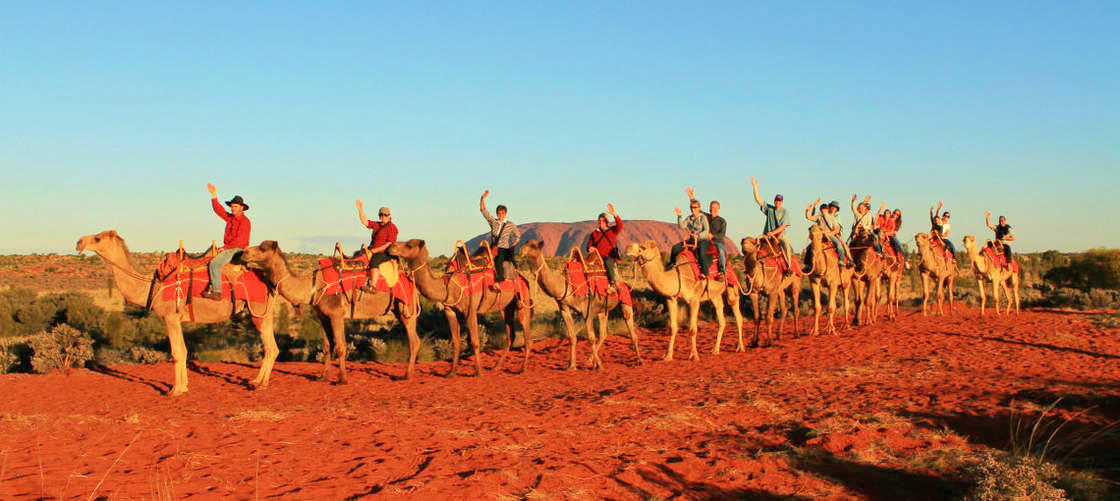
August’s final weeks alleviate this somewhat, as the minimums hover around a chilly-yet-doable 10 degrees Celsius (50 degrees Fahrenheit), while the edge is taken off the daytime heat to produce a wonderfully comfortable average maximum of 28 degrees Celsius (82.4 degrees Fahrenheit).
The flora and fauna of the region have also typically started to swing around to its recovery phase by this time, which serves to add a further layer of colour and life to what is already a marvellous part of the country. Wildflowers in bloom start to dot the area, and their greenery contrasts wonderfully with the reddish hues of the surrounding landscape and Uluru itself in particular. Throw in the lack of school holidays and you’ll save yourself some money during your travels here, too.
It’s inevitable that an adventure to the Outback goes hand-in-hand with flies, but during the warmer months of the year, a face net all but mandatory.

August and its associated time of the year helps to alleviate this greatly, and while you will no doubt still encounter some, the numbers of flies are much more manageable.
Combine all of these elements together and you’ll likely have much more energy with which to enjoy a full day’s worth of exploration of this iconic spot. Walk the base, take a tour, go on a camel ride, visit Kings Canyon and Kata Tjuta/The Olgas, and experience stargazing under incredibly clear skies all without excessive amounts of sweat.
Uluru’s an essential itinerary item for every traveller once in their lives, so aim your trip towards the end of August and you’ll come away with an unforgettable and comfortable journey that will stay with you forever.
Explore Uluru ExperiencesIn addition, if you’re looking for all the top things to see and do in and around Australia including activities, attractions and more, be sure to check out our main Experiences section to browse and book online!
Explore Experiences